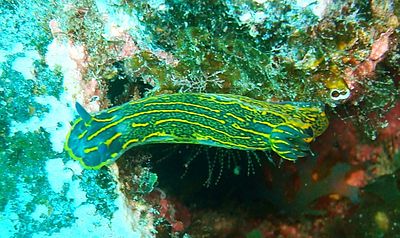Squirrel snails
| Squirrel snails | ||||||||||||
|---|---|---|---|---|---|---|---|---|---|---|---|---|

Triopha catalinae : in front the head with the rhinophores , behind the anus with the gill ring |
||||||||||||
| Systematics | ||||||||||||
|
||||||||||||
| Scientific name | ||||||||||||
| Polyceridae | ||||||||||||
| Alder & Hancock , 1845 |
The squirrel snails ( Polyceridae ) are a family of star snails in the suborder of the nudibranchs . These are small to medium-sized, exclusively marine, caseless snail species that mainly eat bog animals .
features
The Polyceridae are in relation to other star snails of narrower, longer and higher shape. Their body surface is smooth or has only a few warts. The back often has two (in the genus Thecacera ) or several finger-shaped appendages. In many species the head has a forehead sail (velum), which can also carry several extensions (head tentacles), as in the genus Polycera . Because of these horn-like appendages, the animals are also called squirrel snails. The two antennae on the head, the rhinophores , are lamellar in most species. The gills around the anus on the back cannot be retracted.
The snails have a narrow radula with hook-shaped first and sometimes second posterior teeth. Instead of original jaws, the snails have strong bite plates that fulfill the same function. A goiter is missing.
The Polyceridae mainly eat bog animals whose meat is rasped with the radula.
Like other star snails, the Polyceridae are hermaphrodites and mate with each other. They lay their eggs in mostly white egg strings from which numerous Veliger larvae hatch, feed on plankton and, after a long pelagic phase, metamorphose into small star snails .
The Polyceridae include, among others, the spotted squirrel snail ( Palio dubia ), the striped squirrel snail ( Polycera quadrilineata ), the Faroese squirrel snail ( Polycera faeroensis ), the spotted squirrel snail ( Limacia clavigera ) and the helicopter snail ( Thecacera pictera ).
Systematics
According to Bouchet and Rocroi (2005), the family Polyceridae is one of five families in the superfamily Polyceroidea . Seven genera belong to the family:
- Subfamily Polycerinae Alder & Hancock, 1845
- Subfamily Kalinginae Pruvot-Fol , 1956
- Genus Kalinga Alder & Hancock, 1864 (type genus of the subfamily)
- Subfamily Nembrothinae Burn, 1967
- Subfamily Triophinae Odhner, 1941
- Genus Heteroplocamus Oliver, 1915
- Genus Holoplocamus Odhner, 1926
- Genus Joubiniopsis Risbec, 1928
- Genus Kaloplocamus ( Bergh , 1893)
- Genus Limacia OF Müller, 1781
- Genus Plocamopherus (Rüppell & Leuckart, 1831)
- Genus Triopha ( Bergh , 1880) (type genus of the subfamily)
- Genera brought into synonymy
- Genus Cabrilla Fewkes, 1889: synonym of Triopha Bergh, 1880
- Genus Euplocamus Philippi, 1836: synonym of Kaloplocamus Bergh, 1892
- Genus Histiophorus Pease, 1860: synonym of Plocamopherus Rüppell in Rüppell & Leuckart, 1828
- Genus Issa Bergh, 1881: synonym of Colga Bergh, 1880
- Genus Issena Iredale & O'Donoghue, 1923: synonym of Colga Bergh, 1880:
- Genus Laila MacFarland 1905 : synonym of Limacia Muller, 1781
- Genus Peplidia Lowe, 1842: synonym of Plocamopherus Rüppell in Rüppell & Leuckart, 1828
literature
- Luise Schmekel, Adolf Portmann: Opisthobranchia of the Mediterranean: Nudibranchia and Saccoglossa . Springer-Verlag, Berlin Heidelberg New York 1982. Polyceridae Alder and Hancock, 1845 : p. 110.
- Adam Sedgwick, Joseph Jackson Lister, Sir Arthur Everett Shipley: A Student's Text-book of Zoology: Protozoa to Chaetognatha . S. Sonnenschein and Company, 1898. Dorididae : p. 412.
- Philippe Bouchet & Jean-Pierre Rocroi: Part 2. Working classification of the Gastropoda . Malacologia, 47: 239-283, Ann Arbor 2005 ISSN 0076-2997
Web links
Individual evidence
- ↑ Polyceridae in the Integrated Taxonomic Information System (ITIS)
- ^ World Register of Marine Species , Polyceridae Alder & Hancock, 1845
- ↑ Vallès, Y .; Valdés, A .; Ortea, J. 2000. On the phanerobranch dorids of Angola (Mollusca, Nudibranchia): A crossroads of temperate and tropical species. Zoosystema, 22 (1): 15-31.


